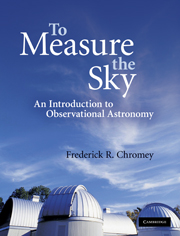8 - Detectors
Published online by Cambridge University Press: 05 June 2012
Summary
Honestly, I cannot congratulate you upon it. Detection is, or ought to be, an exact science, and should be treated in the same cold and unemotional manner. You have attempted to tinge it with romanticism, which produces much the same effect as if you worked a love-story or an elopement into the fifth proposition of Euclid.
“But romance was there,” I remonstrated.
– Arthur Conan Doyle, The Sign of the Four, 1890Astronomical detection, even more than the work of Sherlock Holmes, is an exact science. Watson, though, has an equally important point: no astronomer, not even the coldest and most unemotional, is immune to that pleasant, even romantic, thrill that comes when the detector does work, and the Universe does seem to be speaking.
An astronomical detector receives photons from a source and produces a corresponding signal. The signal characterizes the incoming photons: it may measure their rate of arrival, their energy distribution, or perhaps their wave phase or polarization. Although detecting the signal may be an exact science, its characterization of the source is rarely exact. Photons never pass directly from source to detector without some mediation. They traverse both space and the Earth's atmosphere, and in both places emissions and absorptions may modify the photon stream. A telescope and other elements of the observing system, like correcting lenses, mirrors, filters, optical fibers, and spectrograph gratings, collect and direct the photons, but also alter them. Only in the end does the detector do its work.
- Type
- Chapter
- Information
- To Measure the SkyAn Introduction to Observational Astronomy, pp. 235 - 274Publisher: Cambridge University PressPrint publication year: 2010

